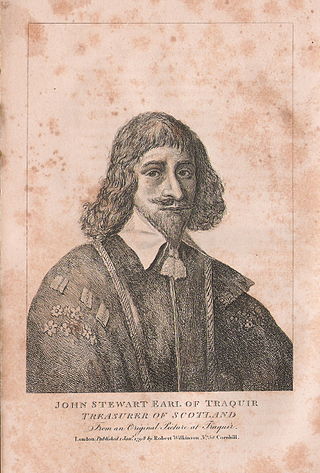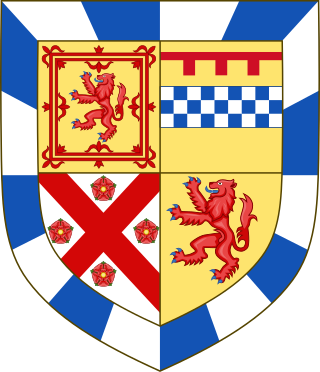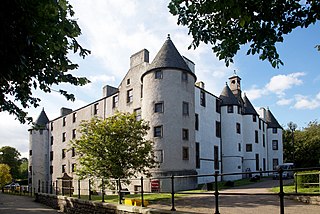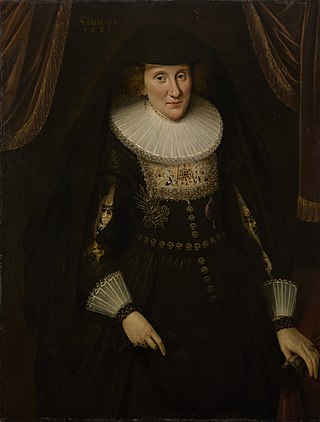Related Research Articles

Thomas Hamilton, 1st Earl of Haddington, designated before his peerage as 'of Drumcarny, Monkland, and Binning', was a Scottish administrator, Lord Advocate, judge, and Lord Lieutenant of Haddingtonshire.

John Stewart, 1st Earl of Traquair was a Scottish statesman who was created Baron Stewart of Traquair in 1628 and Earl of Traquair in 1633.

Patrick Stewart, 2nd Earl of Orkney, Lord of Zetland was a Scottish nobleman, the son of Robert, Earl of Orkney, a bastard son of King James V. Infamous for his godless nature and tyrannical rule over the Scottish archipelagos of Orkney and Shetland, he was executed for treason in 1615.

Sir Patrick Vans of Barnbarroch, or Patrick Vaus, was a Scottish judge and diplomat.

Andrew Stewart, 2nd Lord Ochiltree fought for the Scottish Reformation. His daughter married John Knox and he played a part in the defeat of Mary, Queen of Scots at the battle of Langside.

Andrew Stewart, 1st Baron Castle Stuart (1560–1629) was a Scottish nobleman, soldier, courtier to King James VI and I and one of the chief undertakers in the Ulster Plantation. Stuart resigned his title "Lord Ochiltree" and was made "Baron Castle Stuart".
Sir Roger Aston of Cranford, Middlesex, was an English courtier and favourite of James VI of Scotland.
Gilbert Kennedy of Bargany and Ardstinchar was a Scottish landowner and murder victim. Kennedy had inherited a long-standing family feud with John Kennedy, 5th Earl of Cassilis, on the death of his father, Thomas Kennedy of Bargany. On 11 December 1601 he met the Earl and his followers at Pennyglen near Maybole and was murdered with a lance thrust in his back.
George Young was a Scottish churchman, courtier, member of the Privy Council of Scotland, diplomat, and secretary depute.

Jean Stewart, Lady Bargany was a Scottish lady in waiting to Anne of Denmark. She was a younger daughter of Andrew, Master of Ochiltree and Margaret Stewart, Mistress of Ochiltree. Jean was a maiden in the household of Anne of Denmark and her mother was the senior lady in waiting. Her marriage is of special interest to historians.
William Wallace of Failford,, was a Scottish courtier and landowner.
James Stewart, 1st Lord Doune (1529-1590) was a Scottish landowner.
Elizabeth Stewart, Countess of Arran was a Scottish aristocrat and political intriguer. Several accounts of her actions and ambition were written by her political enemies.
William Stewart of Monkton and Carstairs was a Scottish landowner and courtier.
Margaret Lyon was a Scottish aristocrat and landowner.
Thomas Kennedy of Bargany was a Scottish courtier and landowner.

James Scrimgeour Scottish landowner and Constable of Dundee.

Anna Hay, Countess of Winton (1592-1628) was a Scottish courtier.

John Stewart of Traquair was a Scottish landowner.

Dorothea Stewart, Countess of Gowrie was a Scottish aristocrat. The dates of the birth and death of Dorothea Stewart are unknown.
References
- ↑ James Beveridge & Gordon Donaldson, Register of the Privy Seal: 1556-1567, 5:1 (Edinburgh, 1957), p. 359 no. 1322.
- ↑ Correspondence of Sir Patrick Waus of Barnbarroch (Edinburgh, 1882), p. 215
- ↑ Gordon Donaldson, Register of the Privy Seal of Scotland: 1575-1585, vol. 7 (Edinburgh, 1966), p. 330 no. 2009.
- ↑ Accounts of the Treasurer, vol. 13 (Edinburgh, 1978), p. 401.
- ↑ Correspondence of Sir Patrick Waus of Barnbarroch (Edinburgh, 1882), pp. xxix-xxx, 262, 276-7
- ↑ James Thomson Gibson-Craig, Papers Relative to the Marriage of King James the Sixth of Scotland (Edinburgh, 1836), Appendix pp. 27-28, 35
- ↑ Michael Pearce, 'Anna of Denmark: Fashioning a Danish Court in Scotland', The Court Historian, 24:2 (2019), p. 146. doi : 10.1080/14629712.2019.1626110
- ↑ Annie I. Cameron, Calendar State Papers Scotland: 1593-1595, vol. 11 (Edinburgh, 1936), pp. 657 no. 613, 662-3 no. 619.
- ↑ Register of the Privy Council of Scotland: 1625-1657, 2 ser. vol. 1 (Edinburgh, 1899), p. 201: National Records of Scotland Privy Seal Register, NRS PS1/74 f149r and f201r.
- ↑ David Laing, Correspondence of the Earls of Ancram and Lothian, vol. 1 (Edinburgh, 1875), pp. 20-22
- ↑ David Masson, Register of the Privy Council of Scotland: 1592-1599, vol. 6 (Edinburgh, 1882), pp. 114, 132, 207.
- ↑ James Paterson, History of the County of Ayr, vol. 1 (Ayr, 1847), pp. 380-2: Will NRS ECC9/7/17 pp. 227-232.
- ↑ Register of the Privy Council of Scotland: 1625-1657, 2 ser. vol. 1 (Edinburgh, 1899), pp. 201-202.
- ↑ Calendar State Papers Scotland, vol. 7 (Edinburgh, 1913), p. 533 no. 498.
- ↑ Letters to King James the Sixth from the Queen, Prince Henry, Prince Charles (Edinburgh, 1835), p. lxxii-iii.
- ↑ Chronicle of the Kings of Scotland (Edinburgh, 1830), p. 156: Michael Pearce, 'Anna of Denmark: Fashioning a Danish Court in Scotland', The Court Historian, 24:2 (2019), p. 148.
- ↑ Michael Pearce, 'Anna of Denmark: Fashioning a Danish Court in Scotland', The Court Historian, 24:2 (2019) p. 148.
- ↑ Balfour Paul, Scots Peerage, vol. 8 (Edinburgh, 1911), p. 403.